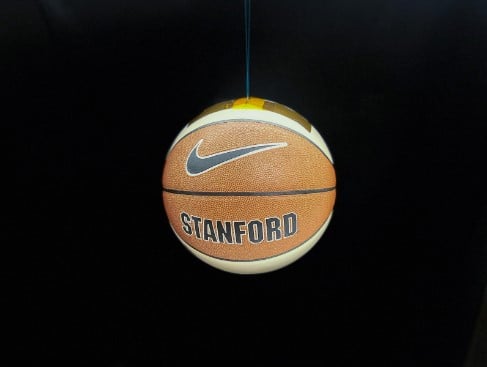The development of the world’s “stickiest non-sticky” material was inspired by the petite feet of the gecko.
Stanford Mechanical Engineering professor Mark Cutkosky’s Biomimetics and Dexterous Manipulation Lab (BDML) studies the properties of this lizard’s uncanny ability to stick to surfaces. In BDML, sixth-year Mechanical Engineering Ph.D. student Tony Chen and fifth-year Mechanical Engineering Ph.D. student Amar Hajj-Ahmad collaborated to develop a dry adhesive tape which mimics the gecko’s grip.
Stanford’s gecko adhesive development project started in the mid-2000s after the United States Department of Defense’s Defense Advanced Research Projects Agency (DARPA) issued a challenge to devise a way for robots to climb walls vertically without suction, Chen said. The adhesive was recently featured in an informational video on the popular YouTube channel Veritasium.
Geckos are a species of lizard that are typically carnivorous, range from about half an inch to a bit more than a foot in size and have a widespread global presence, dwelling in both rainforests and houses.
The anatomy of the gecko’s toe pads equips it with its deft climbing abilities. According to Cutkosky in the video, upon looking closer at a gecko’s toe pads, you may see ribbed sections, which are known as lamella. Lamella are comprised of bristle-like stalks called setae, which end in micron-sized branches called spatula, Cutkosky said.
When a gecko climbs, it relies on adhesion attributed to van der Waals forces — ironically, the weakest intermolecular force — consisting of attraction between neutral atoms. These forces enable the gecko to attach and detach from surfaces as it pleases.
According to Chen, gecko adhesive has better functionality on smooth surfaces since the cragginess of rougher surfaces means there is greater distance between atoms, resulting in a weaker adhesion force. Cutkosky wrote that BDML “continues to try to improve the [gecko adhesive’s] overall performance, especially on non-smooth materials like cardboard and fabric.”
Why geckos? “Geckos are the largest animal that still rely on van der Waals forces,” Chen said. Hajj-Ahmad added that in contrast, heavier animals like elephants and humans rely on frictional forces, which correlate to normal forces and weight. Since smaller organisms are lighter, they cannot generate as much frictional force and depend on van der Waals.
Numerous students have iterated on the material since it was initially developed. “The way that we manufacture it and even the geometry of it have evolved over the past 16-17 years,” Chen said.
According to Hajj-Ahmad, a climbing gecko will “pinch” its toes to engage its adhesion force and then “revers[e] the direction” of “this pinching” to release the surface. The adhesive BDML researchers developed mimics this behavior by firmly adhering to a surface when loaded in one direction and cleanly peeling off when unloaded.
The BDML is not the only lab to work on gecko-inspired adhesives, Cutkosky said.
“The most important difference between most of these and our adhesive is controllability. Our adhesive only sticks when loaded in shear; relaxing the shear force allows it to separate with virtually no effort,” whereas others may require more effort, Cutkosky said.
According to Hajj-Ahmad, the triangular structures seen when zooming into the adhesive enables the variable contact surface area of the tape, letting it have increased area when more grippiness is needed and merely the tip area when the tape is to be released.
Manufacturing the gecko adhesive is a multi-step process. First, a mold is made using a CNC machine. The CNC employs an ultra-sharp microtome blade to indent triangular marks into soft wax, essentially invisible to the naked eye. The adhesive is composed of silicone, prized for its durability and generally unreactive. Next, a certain variant of liquid silicone, selected across parameters like stiffness and viscosity, is poured over the mold, settling in the grooves milled out by the CNC. A backing layer of Kapton, a thin film, is applied on top. When the silicone has cured, it is removed from the mold.
“The beauty of [the gecko adhesive] is that it won’t leave residue behind,” Hajj-Ahmad said, who added that it is also gentler than suction, which can break fragile manufacturing components like quartz or glass wafers.
The gecko adhesive has been subjected to a handful of tests to demonstrate its strength. To Chen, seeing “six tiny robots [pull] a car” with the help of the gecko adhesive was “the most impressive,” along with tests performed on the International Space Station.
The gecko adhesive has its limitations. Currently, each wax mold can only be used “two or three times… because the features in the wax will get damaged,” Haji-Ahmad said. For large-scale manufacturing, “we have to think of more durable ways.”
Gecko adhesives have potential for diverse industry applications. According to Cutkosky, BDML “[has] collaborated with Honda R&D, Ford Motor Company, and Flexiv… among others.” Furthermore, he wrote that a start-up was founded to sell the adhesive.
Chen said it could be applicable in automotive industry assembly lines, which involves the movement of “large, flat parts,” since “gecko adhesives work on smooth surfaces really well.” According to Chen, NASA has expressed interest in gecko adhesive technology for tasks like space debris removal.
“Velcro started in a lab and now it’s a roll-to-roll manufacturing process, and that’s the dream [for the gecko adhesive],” Hajj-Ahmad said.
